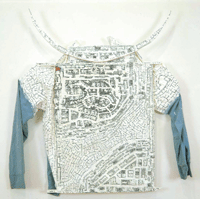Raw, unkempt, his work reflects the underlying messiness of social issues he cares about
I’ve often imagined what it would be like to encounter Kim Jones during one of his Mud Man walks. Would I gawk from across the street, try to follow him, or risk an encounter? With his near naked body covered in mud and muck, and an elaborate hand made wooden rack strapped to his body, I’m pretty sure I’d keep my distance.
I was too young, and on the East Coast when Jones made his marathon California treks in the 1970s. But the pictures evoke certain rawness—an intimidating directness not encountered that often in art these days. The work of William Pope L. comes to mind, but very few others seem willing to engage in the unfettered mess at the heart of large social issues. It’s not unkempt by design, it’s just a gigantic mess.
War is this kind of mess, physically, emotionally, in very way imaginable.
Kim Jones knows something about the subject, having left Vietnam and the Marines as a corporal in 1969. It seems that he has done work mined from those experiences ever since, perhaps most notably in a long and ongoing series of drawings made in the fashion that adolescent boys might employ. Seen in plan, fortifications flanked with labyrinths, deployed with troupes of dots and circles. Tanks roll, defeats are registered as erasures, and victors claim territory through new drawing. History is literally redrawn.
That’s why Kim Jones’ recent show, “War Paint,” at Pierogi seems especially dark. It is alarmingly neat and beautiful. Just as youthful artists now play at expressions of the undone, hoping that the politics of process will attach meaning to their projects, Jones reflects back to us exactly where we are in the scheme of things.
In the main gallery of Jones’ current show at Pierogi are a dozen individual works. One could describe them as paintings—material supports with images on top. Or we could call them wall-mounted sculpture—stiffened garments with abbreviated mud man-like structures attached. Perhaps they are performance objects—a kind of tidy, ready-to-wear mud man outfit for the dirt-adverse. Or, finally, maybe they are just great fashion—flannel and khaki outfitted with Jones’ intensely boyish war drawings on their backs.
No doubt the works have another function for Jones as he studies the multiple meanings that his work has deployed over the years. After all, this is a man who works on the same drawing in 10-year intervals over 30 years. Jones is an historian, exposing that the real story always lies in the revision. And he is a process artist. For while his desire “to study more no more,” as Willie Dixon ‘s hopeful song proclaims, is clear, Jones also knows that finishing this “study” won’t make the subject go away.
gaycitynews.com




































